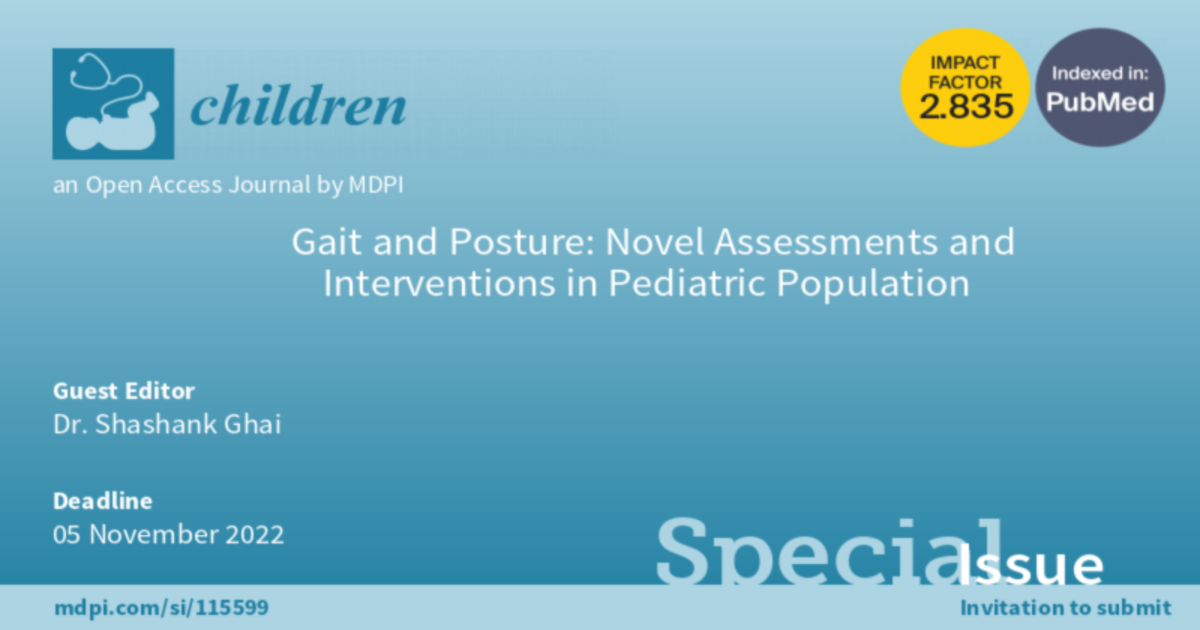Gait and Posture: Novel Assessments and Interventions in Pediatric Population
A special issue of Children (ISSN 2227-9067). This special issue belongs to the section "Pediatric Orthopedics".
Deadline for manuscript submissions: closed (5 November 2022) | Viewed by 12384

Special Issue Editor
Interests: neurorehabilitation; neurophysiology; biomechanics; evidence-based research
Special Issues, Collections and Topics in MDPI journals
Special Issue Information
Dear Colleagues,
In this Special Issue, we intend to accumulate articles that discuss novel assessment methods and interventions regarding aspects of paediatric gait and posture. Papers that qualitatively discuss the needs and experiences of neurologically and orthopaedically affected paediatric population groups will also be included. We intend to incorporate aspects ranging from (but not limited to):
- The study of normal and pathological conditions of paediatric gait and posture.
- Methods for the measurement of healthy, pathological gait and posture in paediatric population.
- Interventions for management of abnormalities in paediatric gait and posture.
- Neurophysiological mechanisms underlying paediatric gait and postural abnormalities.
- Psychological, social, and cultural aspects associated with paediatric rehabilitation.
- Long-term outcomes of pathological conditions of paediatric gait and posture.
- Cost-effectiveness and dose-response analysis of treatment methods.
- The needs and experiences of patients and caregivers undergoing paediatric rehabilitation.
This Special Issue, “Gait & Posture: Novel Assessments & Interventions in paediatric population”, is dedicated to addressing existing gaps in the field of paediatric rehabilitation. It will describe the achievements made in clinical care, education, training, and research. Case studies, research, and review articles are welcome.
We look forward to receiving your contributions.
Dr. Shashank Ghai
Guest Editor
Manuscript Submission Information
Manuscripts should be submitted online at www.mdpi.com by registering and logging in to this website. Once you are registered, click here to go to the submission form. Manuscripts can be submitted until the deadline. All submissions that pass pre-check are peer-reviewed. Accepted papers will be published continuously in the journal (as soon as accepted) and will be listed together on the special issue website. Research articles, review articles as well as short communications are invited. For planned papers, a title and short abstract (about 100 words) can be sent to the Editorial Office for announcement on this website.
Submitted manuscripts should not have been published previously, nor be under consideration for publication elsewhere (except conference proceedings papers). All manuscripts are thoroughly refereed through a single-blind peer-review process. A guide for authors and other relevant information for submission of manuscripts is available on the Instructions for Authors page. Children is an international peer-reviewed open access monthly journal published by MDPI.
Please visit the Instructions for Authors page before submitting a manuscript. The Article Processing Charge (APC) for publication in this open access journal is 2400 CHF (Swiss Francs). Submitted papers should be well formatted and use good English. Authors may use MDPI's English editing service prior to publication or during author revisions.
Keywords
- gait
- posture
- biomechanics
- rehabilitation
- kinematic analysis
- physiotherapy
- experiences
- quality of life
- pediatrics
- caregivers
- social support
- systematic review
- meta-analysis
- cost-effectiveness






